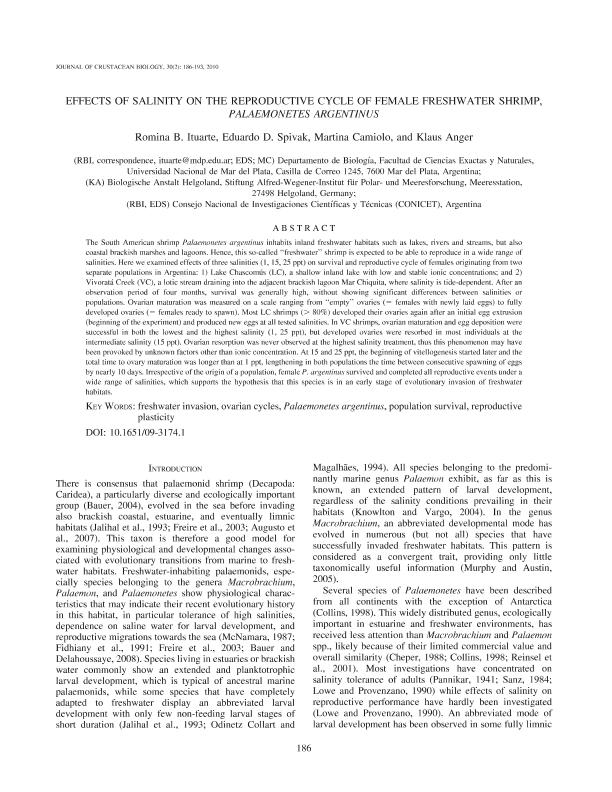Artículo
Effects of salinity on the reproductive cycle of female freshwater shrimp, palaemonetes argentinus
Fecha de publicación:
03/2010
Editorial:
Crustacean Society
Revista:
Journal of Crustacean Biology
ISSN:
0278-0372
Idioma:
Inglés
Tipo de recurso:
Artículo publicado
Clasificación temática:
Resumen
The South American shrimp Palaemonetes argentinus inhabits inland freshwater habitats such as lakes, rivers and streams, but also coastal brackish marshes and lagoons. Hence, this so-called "freshwater" shrimp is expected to be able to reproduce in a wide range of salinities. Here we examined effects of three salinities (1, 15, 25 ppt) on survival and reproductive cycle of females originating from two separate populations in Argentina: 1) Lake Chascoms (LC), a shallow inland lake with low and stable ionic concentrations; and 2) Vivorat Creek (VC), a lotic stream draining into the adjacent brackish lagoon Mar Chiquita, where salinity is tide-dependent. After an observation period of four months, survival was generally high, without showing significant differences between salinities or populations. Ovarian maturation was measured on a scale ranging from "empty" ovaries ( females with newly laid eggs) to fully developed ovaries ( females ready to spawn). Most LC shrimps (> 80) developed their ovaries again after an initial egg extrusion (beginning of the experiment) and produced new eggs at all tested salinities. In VC shrimps, ovarian maturation and egg deposition were successful in both the lowest and the highest salinity (1, 25 ppt), but developed ovaries were resorbed in most individuals at the intermediate salinity (15 ppt). Ovarian resorption was never observed at the highest salinity treatment, thus this phenomenon may have been provoked by unknown factors other than ionic concentration. At 15 and 25 ppt, the beginning of vitellogenesis started later and the total time to ovary maturation was longer than at 1 ppt, lengthening in both populations the time between consecutive spawning of eggs by nearly 10 days. Irrespective of the origin of a population, female P. argentinus survived and completed all reproductive events under a wide range of salinities, which supports the hypothesis that this species is in an early stage of evolutionary invasion of freshwater habitats. © 2010 The Crustacean Society.
Archivos asociados
Licencia
Identificadores
Colecciones
Articulos(IIMYC)
Articulos de INSTITUTO DE INVESTIGACIONES MARINAS Y COSTERAS
Articulos de INSTITUTO DE INVESTIGACIONES MARINAS Y COSTERAS
Citación
Ituarte, Romina Belen; Spivak, Eduardo Daniel; Camiolo, Martina Daniela; Anger, Klaus; Effects of salinity on the reproductive cycle of female freshwater shrimp, palaemonetes argentinus; Crustacean Society; Journal of Crustacean Biology; 30; 2; 3-2010; 186-193
Compartir
Altmétricas




